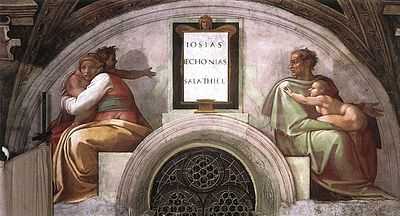Jehoahaz of Judah

Jehoahaz or Joachaz in the Douay-Rheims and some other English translations (Hebrew: יְהוֹאָחָז, Modern Yeho'aẖaz Tiberian Yəhôʼāḥāz ; "Yahweh has held"; Greek: Ιωαχαζ Iōakhaz; Latin: Joachaz) was king of Judah (3 months in 609 BC) and the third son of king Josiah whom he succeeded[1] and Hamautal, daughter of Jeremiah of Libnah. He was born in 633/632 BC and his birth name was Shallum (1 Chronicles 3:15).
Background
In the spring or early summer of 609 BC, Necho II began his first campaign against Babylon, in aid of the Assyrians. He moved his forces along the coastal route Via Maris towards Syria, along the low tracts of Philistia and Sharon and prepared to cross the ridge of hills which shuts in the Jezreel Valley on the south. There he found his passage blocked at Megiddo by the Judean army led by Josiah, who sided with the Babylonians. After a fierce battle Josiah was killed. The Assyrians and their allies the Egyptians fought the Babylonians at Harran. The Babylonian Chronicle dates the battle from Tammuz (July–August) to Elul (August–September) of 609 BC. Josiah was therefore killed in the month of Tammuz, 609 BC, or the month prior, when the Egyptians were on their way to Harran.[2] Chronological considerations related to his successor limit the month in which Josiah was killed and Jehoahaz took the throne to Tammuz.
Reign
| Rulers of Judah |
|---|
Although he was two years younger than his brother, Eliakim, he was elected to succeed his father on the throne at the age of twenty-three, under the name Jehoahaz. He reigned for only three months,[1] before being deposed by the Egyptian Pharaoh Necho II (2 Kings 23:31-34) and taken into Egyptian captivity.
He disregarded the reforms of his father Josiah. (2 Kings 23:32; Jeremiah 22:15-16)
Both William F. Albright and E. R. Thiele dated his reign to 609 BC,[3] making his birth in 633/632 BC. Jehoahaz was the first king of Judah to die in exile.[citation needed]
Necho II Deposes Jehoahaz
Jehoahaz had ruled for three months when Necho II appointed his older brother Eliakim as king, changing his name to Jehoiakim.[4] Necho brought Jehoahaz north to Riblah and imprisoned him there.[5] Necho proceeded with his first campaign, joining forces with the Assyrian Ashur-uballit II and together they crossed the Euphrates and laid siege to Harran, which they failed to capture and the Assyrian Empire collapsed. On his return march, Necho brought Jehoahaz back to Egypt as his prisoner, where Jehoahaz ended his days.[6] [7]
| Jehoahaz of Judah | ||
| Regnal titles | ||
|---|---|---|
| Preceded by Josiah |
King of Judah Tammuz (July) to Tishri (October) 609 BC |
Succeeded by Jehoiakim |
References
- ↑ 1.0 1.1 Kautzsch, E. "Jehoahaz", The New Scaff-Herzog Encyclopedia of Religious Knowledge, Vol.IV, Samuel Macauley Jackson (ed.), Baker Book House, Grand Rapids, Michigan (1953)
- ↑ Thiele, 182, 184-185.
- ↑ Edwin Thiele, The Mysterious Numbers of the Hebrew Kings, (1st ed.; New York: Macmillan, 1951; 2d ed.; Grand Rapids: Eerdmans, 1965; 3rd ed.; Grand Rapids: Zondervan/Kregel, 1983). ISBN 0-8254-3825-X, 9780825438257, 217.
- ↑ 2 Chronicles 36:4
- ↑ 2 Kings 23:33
- ↑ 2 Kings 23:34
- ↑ Philip J. King, Jeremiah: An Archaeological Companion (Westminster John Knox Press, 1993), page 20.
| ||||||||||||||||||||||||||